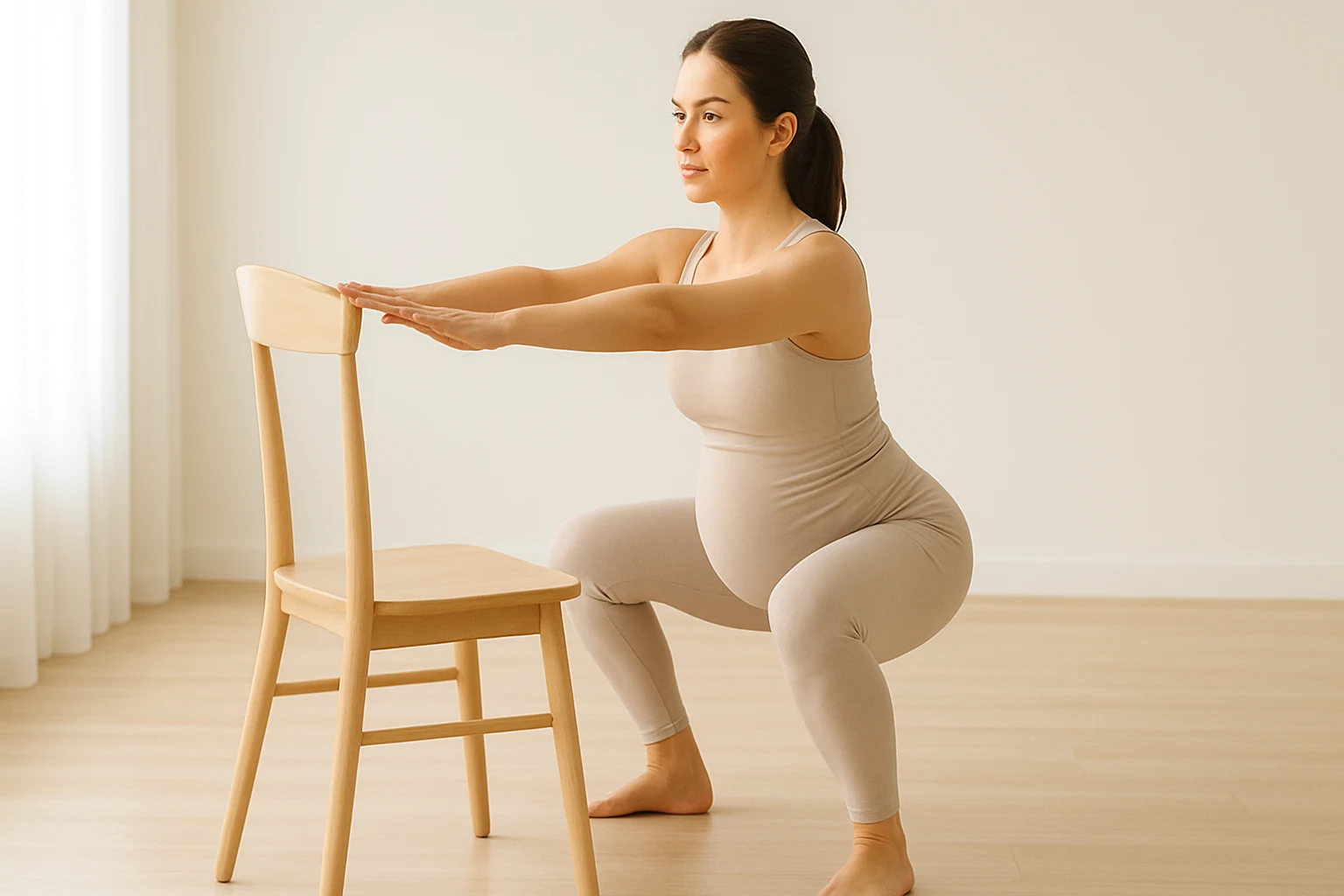
Hello, expectant mother! Pelvic floor exercises for pregnant women may help manage bladder leaks and support a smoother labor. These muscles act as your body’s internal support, cradling your growing baby, potentially easing birth, and aiding recovery. This guide explains why strengthening these muscles is beneficial, how to do it safely, and how to incorporate it into daily life. For expert insights, practical tools, and more on pelvic health, see women’s pelvic health.
Table of Contents
Key Pelvic Floor Therapy Benefits in Pregnancy
Pelvic floor exercises for pregnant women can support birth prep and may help reduce bladder leaks.
- Boost Birth & Recovery: Strong pelvic floor muscles may support a smoother labor, potentially reduce the risk of tearing, and aid in postpartum recovery with pelvic floor strength.
- Control Your Bladder: These exercises may help reduce common pregnancy bladder leaks, supporting comfort and confidence with pregnancy pelvic floor exercises.
- Safe & Simple Moves: Learn easy-to-do exercises like Kegels, diaphragmatic breathing, bridges, and modified squats that are safe throughout pregnancy.
- Consistency is Key: Aim for regular, short exercise sessions – a few minutes, a few times a day – to build lasting strength without overdoing it.
- Avoid Over-Tightening: It’s important to practice both a gentle lift and a full release to prepare for birth and prevent discomfort.
This post has affiliate links. We may earn a commission. Learn more.

Why Pelvic Floor Strength Matters During Pregnancy
Picture a hammock stretching from your tailbone to your pubic bone. That’s your pelvic floor! These muscles support your bladder, uterus, and bowels. During pregnancy, they work overtime to hold your growing baby. The benefits of pelvic floor therapy may include less pain and better stability. According to the American College of Obstetricians and Gynecologists, staying active in pregnancy offers multiple benefits, and pelvic floor training is commonly recommended to support bladder control and comfort. For additional pelvic pain relief, some women explore healing touch therapy. Here’s why pelvic floor strengthening is a game-changer:
- Support for Your Growing Baby: As your baby grows, the pressure on these muscles increases. Strong muscles may reduce pelvic pain or heaviness.
- Easier Labor and Delivery: Your pelvic floor acts like a door, needing strength to guide your baby out and flexibility to open during labor, which may help reduce tearing.
- Better Bladder Control: Pelvic floor exercises for pregnant women may strengthen the muscles supporting bladder control, potentially reducing leaks.
- Faster Postpartum Recovery: Pre-strengthened muscles may recover faster post-birth, supporting bladder control, bowel function, and sexual health.
- Preventing Future Problems: Maintaining pelvic health may help lower future risks like pelvic organ prolapse.
Your pelvic floor muscles are the unsung heroes of pregnancy and childbirth. Strengthening them is an investment in your comfort, control, and recovery.
Safe Pelvic Floor Exercises in Pregnancy
When you practice pelvic floor exercises for pregnant women, start gently, tune in to what feels right, and check with your doctor or a pelvic floor physical therapist if anything hurts.
If you’re new to these movements or have symptoms like pain, heaviness, or leaking, consult a clinician before increasing intensity.
Kegel Exercises: The Foundation
Kegels are the cornerstone of pregnancy pelvic floor exercises. First, identify the right muscles by imagining stopping urine mid-stream or preventing gas. Avoid squeezing your tummy, butt, or thighs.
Tips to Nail It:
- Quality over quantity—don’t rush through sloppy reps.
- Keep breathing nice and deep, like you’re savoring a calm moment.
- Make it fun! Try these during your favorite show or while waiting for your coffee to brew.
Step-by-Step Guide:
- Slow Kegels (Endurance):
- Sit, stand, or lie comfortably.
- Squeeze and lift your pelvic floor muscles, like lifting a small marble.
- Hold for 3–5 seconds, breathing normally.
- Relax completely for 3–5 seconds.
- Repeat 10–15 times.
- Fast Kegels: Quick and Easy Strength Boost
- Gently squeeze and lift your pelvic floor muscles (think of stopping a sneeze or holding in a giggle).
- Let go right away—no lingering!
- Do this 10–15 times in a row, keeping it snappy.
Diaphragmatic Breathing for Pelvic Floor Strengthening
This breathing trick is like a little spa day for your soul—it melts away stress while giving your pelvic floor a gentle workout. Here’s how to get started:
Step-by-Step Guide:
- Snuggle into a comfy spot—lie down with your knees bent or sit somewhere cozy.
- Take a deep, happy breath in through your nose, letting your belly puff up like a soft balloon. Feel those muscles loosen and relax.
- Let out a slow, gentle exhale through your mouth, watching your belly sink back down. They’ll give a little lift, like a soft hug from within.
- Keep this flow going for 5–8 minutes, soaking in that calm, easy rhythm.
Why You’ll Love It:
- It’s your go-to for unwinding and keeping these muscles flexible and strong—setting you up beautifully for delivery.

Bridge Pose Practice
Bridge pose strengthens your glutes, hamstrings, and lower back, supporting these muscles. It also promotes a gentle pelvic tilt.
Step-by-Step:
- Lie with knees bent, feet flat, hip-width apart.
- Exhale and push through heels to lift hips, forming a straight line.
- Engage glutes and these muscles at the top.
- Hold for 3 seconds, breathing normally.
- Lower slowly, relaxing your pelvis.
- Repeat 8–12 reps.
Tip: Use a pillow under your chest in later trimesters if lying flat feels odd.
Tailored Squats
Squats strengthen your legs and glutes, supporting your pelvis. They promote healthy muscle engagement.
Step-by-Step:
- Stand with feet wider than hips, toes slightly out.
- Inhale and lower hips like sitting back, relaxing your pelvic floor.
- Exhale and push through heels to stand, gently lifting your pelvic floor.
- Repeat 8–12 reps.
Tip: Use a chair for balance as your belly grows.
How Often to Do Pelvic Floor Exercises for Pregnant Women
Pregnancy pelvic floor exercises are generally considered safe across all trimesters for most people. Starting early may maximize benefits, but even third-trimester beginners can see progress.
If you notice increased symptoms (pain, heaviness, leaks), scale back and check in with a clinician or pelvic floor PT.
When to Start
Begin in the first trimester for a strong foundation. However, starting later still helps prepare for labor.
Recommended Frequency
Consistency beats intensity. Aim for:
- Frequency: 3–5 times daily.
- Duration: 5–10 minutes per session.
Here’s a sample routine:
| Time of Day | Exercise | Repetitions/Duration |
|---|---|---|
| Morning | Kegels | 10 slow, 10 fast |
| Mid-day | Diaphragmatic Breathing | 5 minutes |
| Afternoon | Bridge Pose | 8–12 reps |
| Evening | Kegels | 10 slow, 10 fast |
| Before Bed | Tailored Squats | 8–12 reps |
Common Mistakes in Pregnancy Pelvic Floor Training
With pelvic floor exercises for pregnant women, avoid common pitfalls that can slow your progress or create tension. Watch out for:
- Holding Your Breath: This adds pressure. Instead, breathe deeply.
- Squeezing Other Muscles: Isolate these muscles. Practice lying down to feel them.
- Not Relaxing: Fully relax your pelvic floor muscles after each contraction to avoid tension and potential discomfort.
- Overdoing It: Ease into it—start small to keep from wearing yourself out.
- Ignoring Pain: If anything hurts, pause and check with a professional to keep things safe and comfy.
The secret to a healthy pelvic floor isn’t just strength; it’s balance – learning to both contract and fully relax these vital muscles.

Interactive Tool: Pelvic Floor Routine Builder
Pelvic Floor Routine Builder
Choose your trimester and time to get a personalized pelvic floor exercise plan.
Select both options to see your routine.
Frequently Asked Questions
Conclusion: Rock Your Pregnancy with a Strong Pelvic Floor
Your pelvic floor plays a vital role during pregnancy, quietly supporting your body’s needs. By incorporating pregnancy pelvic floor exercises into your routine, you may support an easier birth, help reduce bladder leaks, and promote postpartum recovery. Make pelvic floor strengthening a daily habit, listen to your body, and consult a pelvic floor therapist for personalized guidance.